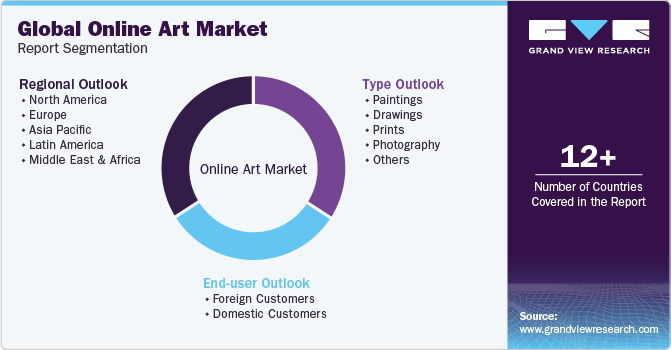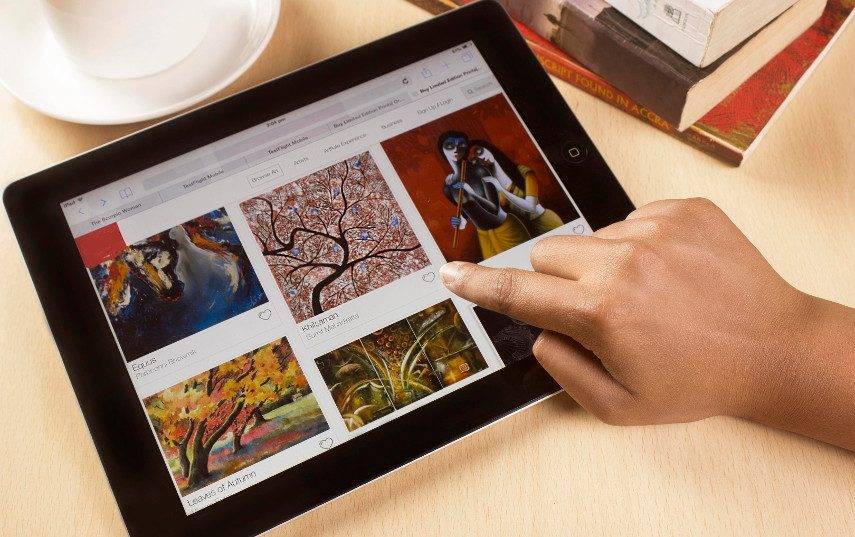For centuries, the art world has thrived on physical interactions. Galleries, museums, and auction houses served as the primary platforms for artists to showcase their work and for collectors to discover and acquire pieces. However, the digital revolution has ushered in a new era, transforming the way art is bought, sold, and experienced. This article delves into the growth of the online art market, exploring its global trends and its specific impact on the vibrant Indian art scene.

A Booming Digital Landscape: Global Trends in the Online Art Market
The online art market has witnessed remarkable growth in recent years. Here’s a glimpse into the key drivers of this phenomenon:
- Increased Internet Penetration and Mobile Adoption: With a growing number of people accessing the internet, particularly through smartphones, online platforms have become readily accessible. This has opened doors for a wider audience to explore and engage with art.
- Convenience and Accessibility: Online platforms offer a user-friendly experience, allowing buyers to browse artworks from across the globe at their own pace. This eliminates geographical limitations and provides greater flexibility compared to traditional methods.
- Transparency and Information: Online marketplaces often provide detailed information about artists, their backgrounds, and the artworks themselves. This transparency fosters trust and empowers buyers to make informed decisions.
- Evolving Demographics: Millennial and Gen Z art collectors are increasingly tech-savvy and comfortable with online transactions. This shift in demographics fuels the demand for online art platforms.
- The Pandemic Effect: The COVID-19 pandemic significantly impacted the art world, with physical galleries and auction houses facing closures. This accelerated the shift towards online platforms, both for established institutions and emerging artists.
Market Size and Growth Projections: According to Grand View Research, the global online art market was valued at USD 9.18 billion in 2022 and is expected to reach USD 17.76 billion by 2030, reflecting a Compound Annual Growth Rate (CAGR) of 9.0%. This substantial growth indicates the increasing prominence of online channels in the art market.
Impact on Traditional Players: While online platforms are gaining traction, traditional art institutions are not being left behind. Many galleries and auction houses have embraced digital tools, offering virtual tours, online auctions, and enhanced online presence. This convergence of the physical and digital realms creates a more holistic art experience.
The Indian Art Scene Goes Online: A Land of Rich Artistic Heritage
India boasts a rich artistic heritage spanning centuries, encompassing diverse styles and mediums. From the intricate miniature paintings of Mughal courts to the vibrant folk art traditions, Indian art reflects a unique cultural tapestry. The online art market offers exciting possibilities for this dynamic art scene:
- Wider Reach for Indian Artists: Online platforms provide Indian artists with a global audience, allowing them to showcase their work beyond geographical limitations. This can lead to increased recognition and opportunities for international exposure.
- Democratization of Art Collecting: Online platforms make art more accessible to a wider range of Indian collectors. Affordable artworks and easy payment options can encourage new collectors to participate in the art market.
- Support for Emerging Artists: Online platforms can be a launchpad for emerging Indian artists who might not have access to established galleries. They can connect directly with collectors and build a loyal following.
- Preservation of Art Forms: Online platforms can serve as valuable archives for documenting and preserving traditional Indian art forms, ensuring their accessibility for future generations.
Challenges and Considerations:
Despite the promising prospects, the online art market in India also faces certain challenges:
- Digital Divide: Unequal access to the internet and digital literacy can hinder participation in the online art market, particularly for artists and collectors in remote areas.
- Concerns about Authenticity and Quality: Verifying the authenticity and quality of artworks online can be a concern for collectors. Robust authentication processes and high-resolution images are crucial for building trust.
- Logistics and Infrastructure: Efficient logistics and secure payment gateways are essential for seamless online art transactions.
The Road Ahead: A Future Filled with Creativity and Connection
The online art market in India is at a nascent stage, but it holds immense potential for growth. By addressing challenges and fostering collaboration between online platforms, artists, and traditional institutions, India can leverage the digital revolution to further enrich its vibrant art scene.
Here are some potential future directions:
- Integration of Technology: Technologies like virtual reality (VR) and augmented reality (AR) can create immersive online experiences, allowing collectors to virtually view artworks in their own spaces.
- Blockchain and NFTs: Blockchain technology and Non-Fungible Tokens (NFTs) have the potential to revolutionize art ownership and provenance tracking in the online space.
- Focus on Education and Awareness: Promoting digital literacy and educating potential buyers and sellers about online art platforms can foster wider participation.
- Government Initiatives: The Indian government can play a crucial role in supporting the growth of the online art market through initiatives such as:
- Developing E-commerce Infrastructure: Investing in infrastructure to improve internet connectivity and digital payment systems across the country can bridge the digital divide and empower wider participation.
- Promoting Cultural Awareness Programs: Government-supported programs that educate the public about the value of art and the benefits of collecting can cultivate a stronger art market ecosystem.
- Supporting Artist Networks and Training: Providing training programs for artists to develop their online presence and marketing skills can equip them to thrive in the digital art market.
- Case Studies: Success Stories in the Indian Online Art Market
- Several online platforms are making significant strides in shaping the Indian online art market:
- Online Art Galleries: Platforms like Akriti Art Gallery, Artflute, and DAG showcase established and emerging artists, offering a curated selection of artworks across various mediums and price points.
Auction Houses: Online platforms like Saffronart and Sotheby’s India conduct online auctions, reaching a wider audience and offering greater transparency in the bidding process.
Artist-Run Initiatives: Platforms like The Guild and InKo Centre connect collectors directly with artists, fostering a more personal connection and supporting independent artistic practices.
These success stories demonstrate the potential of online platforms to empower artists, reach new audiences, and contribute to the growth of the Indian art market.
Conclusion: A Symphony of Tradition and Technology- The online art market presents a dynamic and exciting chapter in the evolution of the Indian art scene. It offers a unique opportunity to bridge geographical divides, democratize art collecting, and celebrate India’s rich artistic heritage on a global stage. By embracing technology, fostering collaboration, and addressing existing challenges, India can position itself as a leader in the global online art market, ensuring a future filled with creativity and connection.
Further Considerations:- This article provides a broad overview of the online art market in India. Here are some suggestions for further exploration: Research specific online art platforms in India and their unique offerings. Explore the impact of the online art market on specific art forms or artistic communities in India. Investigate the role of art critics and curators in the online art market.
- Analyze the legal and regulatory landscape surrounding online art transactions in India.
- By delving deeper into these aspects, you can gain a more comprehensive understanding of the online art market and its transformative impact on the Indian art scene.
Visions Art is a dynamic platform that bridges the gap between artists, collectors, and art enthusiasts. Here’s how it contributes to making art collection more accessible:
- Curated Selection: Visions Art curates a diverse range of artworks, ensuring that collectors have access to high-quality pieces across various styles, genres, and price points. By carefully selecting artists and their works, they create a marketplace that appeals to both seasoned collectors and newcomers.
- Affordability: One of the barriers to art collection is the perception that it’s expensive. Visions Art actively promotes affordable art, featuring emerging artists alongside established names. This democratization of art allows individuals with varying budgets to start or expand their collections.
- Educational Resources: Visions Art goes beyond being a mere marketplace. They provide educational content, including artist profiles, art history insights, and collecting tips. By empowering buyers with knowledge, they encourage informed decisions and foster a deeper appreciation for art.
- Virtual Exhibitions and Events: Especially in the digital age, Visions Art hosts virtual exhibitions, allowing users to explore artworks from the comfort of their homes. These events feature interactive elements, artist interviews, and behind-the-scenes glimpses, enhancing the overall art-buying experience.
- Transparent Transactions: Trust is crucial in online art purchases. Visions Art emphasizes transparency by providing detailed information about each artwork, including its provenance, condition, and any relevant certifications. Buyers can make informed choices, knowing they’re investing in authentic pieces.
- Support for Emerging Artists: Visions Art actively supports emerging talents by showcasing their work. This exposure helps artists gain recognition and build their careers. As collectors discover fresh voices, they contribute to the growth of the art ecosystem.
- Community Building: Beyond transactions, Visions Art fosters a sense of community. Collectors can connect with fellow enthusiasts, share their experiences, and participate in discussions. This sense of belonging encourages more people to engage with art.

